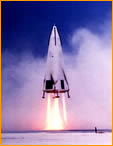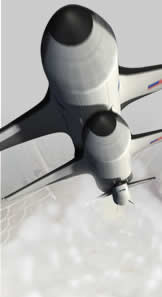


|
|
 |



Several USL employees were key personnel in the Delta Clipper flight
program (More Info).
The DC-X/A vehicle was the first flying prototype of the next generation
reusable launch vehicle.
 to download a QuickTime movie of one the successful flights.
to download a QuickTime movie of one the successful flights.
 to access a summary web page created by NASA to document the successful
DC-X/XA program.
to access a summary web page created by NASA to document the successful
DC-X/XA program. |
 |
 |
 |
 |
| PROJECT |
CONTRACTING
ORGANIZATION |
PROJECT
DESCRIPTION |
|
 |
 |
 |
 |
 |
Low Cost Bantam Operating
System Demonstration |
 |
NASA – Marshall
Space Flight Center |
 |
USL developed a Bantam
system operations concept based on DC-X/A lessons learned. Our team
built a simulation of the Bantam system operation as a prototype
for the integrated ground and flight operational system, including
a tailored model for the Bantam operations control center. USL delivered
a demonstration of a working automated mission planning (AMP) system.
This effort also prototyped man-machine interfaces and displays
for a generic mission planning and GN&C design tool. |

 |
Phase I SBIR: Launch
Vehicle Integrated Guidance Software - Reducing Operations Cost
|
 |
NASA – Marshall
Space Flight Center |
 |
USL developed and demonstrated
an integrated guidance software system that addresses the end-to-end
mission of an RLV (i.e., pre-flight planning through landing). Ascent,
on-orbit, entry, and abort guidance schemes were linked to a streamlined,
automated mission design environment to allow rapid mission development.
|

 |
Simulation-Based R&D
for Space Vehicle Concepts |
 |
United States Air Force |
 |
Under this Phase I SBIR
effort, USL developed the Integrated Database System (IDS) proving
the feasibility and advantages of an integrated development and
operations system approach to the development of simulation-based
R&D tools. A series of 47 incremental development steps and
tests were completed during the Phase I program leading up to a
fully integrated test of the end-to-end IDS system. |

 |
The Impact of Space
Commercialization and Reusable Launch Vehicles on the Office of
Space Launch Mission |
 |
Office of Space Launch,
National Reconnaissance |
 |
USL conducted a one-year
study contract for the National Reconnaissance Office (NRO) to address
how new, commercially-proposed reusable and expendable launch capabilities
would impact the NRO’s Office of Space Launch mission planning
and control activities in the future. USL lead a team that included
Boeing, Pratt & Whitney and Kelly Space and Technology to survey
proposed commercial and military launch systems in FY2000, catalog
them, and assess their technical, operational, and financial (business
plan) merits. USL also used this survey and other information contributed
by Boeing and Pratt & Whitney to extrapolate alternative futures
that the launch industry could experience in the near future. |

 |
Software Support to
the Scripps-NISTAR Project |
 |
Ball Aerospace and Technologies
Corp. |
 |
USL supported the flight
software verification in a processor-in-the-loop test environment
for the Deep Impact spacecraft. |
|



|











